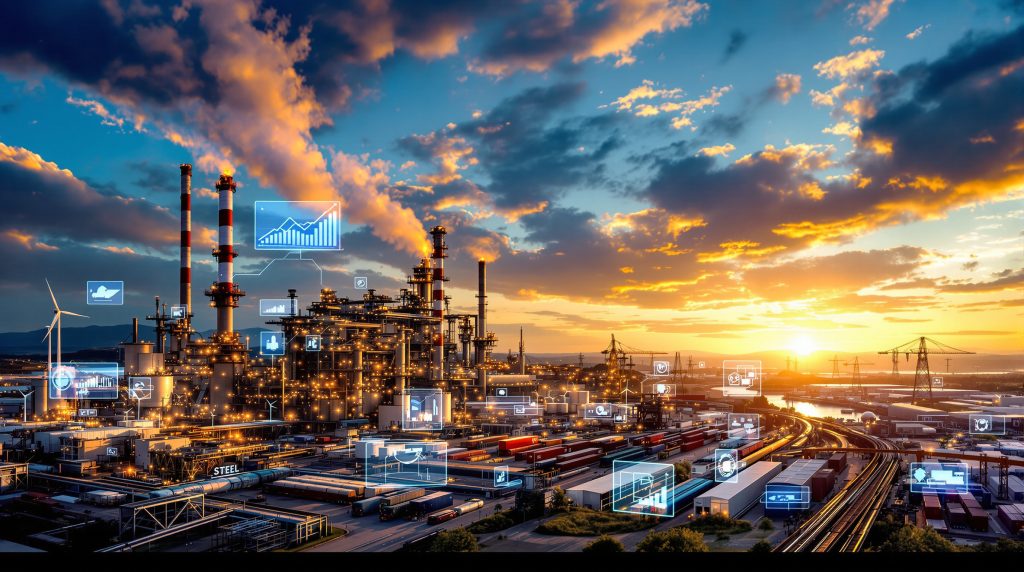Understanding Steel's Strategic Value Beyond Traditional Military Applications
The relationship between the domestic steel industry and national security extends far beyond the production of tanks, ships, and military equipment. While defense applications consume only approximately 2-3% of America's total steel output, industry experts emphasise that true national security encompasses the ability to maintain critical infrastructure, support communities, and ensure economic independence during global disruptions.
Barry Zekelman, CEO of Zekelman Industries, articulated this broader perspective in a recent interview, explaining that national security represents America's capacity to conduct daily operations and sustain communities without foreign dependence. The COVID-19 pandemic demonstrated how supply chain vulnerabilities can trigger significant inflation when domestic manufacturing capacity proves insufficient to meet essential needs.
This comprehensive view of steel's security role becomes particularly relevant when examining the interconnected nature of modern infrastructure. Data centres supporting digital communications, renewable energy installations, and traditional power generation all require extensive steel components throughout their supply chains, from initial construction to ongoing operations.
Supply Chain Vulnerabilities Revealed Through Recent Disruptions
Recent global events have exposed critical weaknesses in America's steel supply chains, particularly regarding infrastructure that citizens depend on daily. The pandemic-era disruptions served as a stark reminder that over-reliance on foreign suppliers can create significant economic and security challenges when international trade routes become compromised.
Manufacturing capacity shortfalls during emergencies don't simply affect industrial operations; they cascade through entire economic systems, creating inflationary pressures and limiting the ability to maintain essential services. These disruptions highlighted the strategic importance of maintaining robust domestic steel production capabilities that can respond rapidly to changing demand patterns without depending on international supply chains.
Furthermore, the steel industry's technological advancement often goes unrecognised by the general public, with some Americans surprised to learn that domestic steel production still exists. This perception gap reflects a broader disconnect between the industry's actual capabilities and public awareness of its strategic importance.
Critical Infrastructure Sectors Dependent on Domestic Steel Security
Energy Infrastructure and Grid Reliability
America's energy independence relies heavily on domestic steel production across multiple interconnected sectors. The extraction, transportation, and refinement of energy resources require extensive steel infrastructure, yet current statistics reveal concerning dependencies on foreign suppliers.
Approximately 50% of oil and gas transportation in the United States relies on foreign-manufactured pipe and tube products, according to industry data. This dependency extends beyond fossil fuels to encompass the entire energy ecosystem, including renewable energy installations and power transmission networks.
Key energy sector dependencies include:
• Deep-water drilling operations: Gulf of Mexico extraction requires specialised steel piping capable of withstanding extreme pressures and corrosive environments
• Pipeline networks: Thousands of miles of pipeline infrastructure transport oil, gas, and refined products across the continent
• Renewable energy systems: Wind turbines, solar panel mounting systems, and associated electrical infrastructure require high-quality steel components
• Power transmission: Electrical grid towers, transmission lines, and distribution systems depend on steel for structural integrity and electrical conductivity
The energy sector's steel requirements extend from initial extraction through final delivery to consumers. Hydraulic fracturing operations depend on steel pipe systems, whilst liquefied natural gas terminals require extensive steel construction for storage and processing facilities. Moreover, iron ore price trends significantly influence the cost structure of domestic steel production, affecting the sector's competitiveness against foreign suppliers.
Data Centre Expansion and Digital Infrastructure Requirements
The exponential growth of digital infrastructure creates unprecedented demand for steel-intensive construction projects. Data centres supporting cloud computing, artificial intelligence, and digital communications require specialised steel applications throughout their design and construction phases.
Modern data centres demand:
• Structural steel frameworks: Earthquake and hurricane-resistant construction requires high-strength steel components
• Cooling system infrastructure: Extensive steel piping networks distribute coolant throughout facilities
• Electrical distribution systems: Steel-based mounting and protection systems support high-voltage electrical equipment
• Backup power generation: Emergency power systems rely on steel construction for generators and fuel storage
The interconnected nature of digital infrastructure means that data centres depend on steel throughout their entire operational ecosystem. Power generation facilities supplying electricity to data centres utilise steel in extraction, transportation, and generation processes. Transmission networks delivering power rely on steel towers and components, creating multiple dependencies that extend far beyond the data centre facility itself.
Water Infrastructure Dependencies
Perhaps even more concerning than energy sector dependencies, 50% of America's drinking water travels through foreign-manufactured pipe systems. This statistic reveals a fundamental vulnerability in one of society's most essential services, where supply disruptions could directly impact public health and safety.
Transportation Networks and Strategic Mobility
Critical transportation infrastructure supporting both civilian and military mobility depends on continuous steel supply for maintenance, expansion, and modernisation projects. These networks form the backbone of economic activity and emergency response capabilities.
Transportation steel requirements include:
• Bridge construction and rehabilitation: Ageing infrastructure requires ongoing steel-intensive maintenance and replacement programmes
• Railway expansion projects: Freight and passenger rail systems need steel rails, bridges, and support structures
• Port facility development: International trade terminals require steel construction for cargo handling and storage
• Airport infrastructure: Both civilian and dual-use airports depend on steel for runways, terminals, and support facilities
Trade Policy Impacts on Steel Industry National Security
Section 232 Tariffs and Strategic Protection Framework
The implementation of Section 232 tariffs in 2018 represented a significant shift in U.S. trade policy, recognising steel production as essential to national security. These measures aimed to preserve domestic production capacity whilst addressing unfair foreign competition and subsidisation practices.
However, U.S. steel‐aluminum tariffs continue to evolve, with ongoing discussions about exemptions and modifications that could affect the domestic steel industry and national security. These policy changes reflect the complex balance between protecting domestic capacity and maintaining cost-competitive supply chains.
Key U.S. Steel Trade Protection Measures:
| Policy Tool | Implementation | Primary Focus | Security Rationale |
|---|---|---|---|
| Section 232 Tariffs | 2018 | Global imports | Preserve production capacity |
| Anti-dumping duties | Ongoing | Subsidised exports | Counter unfair pricing |
| Buy American provisions | Various years | Federal procurement | Ensure domestic sourcing |
| USMCA requirements | 2020 | Regional trade | Strengthen North American supply chains |
Current trade policies operate within a complex global environment characterised by shifting trade flows and increased focus on supply chain security. The second Trump administration's emphasis on reshoring critical manufacturing has intensified discussions about balancing economic efficiency with strategic preparedness.
Addressing Competitive Disadvantages Through Fair Trade
Industry leaders argue that American steel producers can compete globally when foreign subsidisation is eliminated from the competitive equation. The United States possesses several natural advantages that should enable export leadership rather than import dependence.
American Steel Industry Competitive Advantages:
• Energy costs: Among the lowest globally, providing significant input cost advantages
• Iron ore quality: Access to high-grade domestic ore deposits reduces processing requirements
• Technology leadership: Advanced production methods and equipment enhance efficiency
• Labour productivity: Modern steelmaking minimises labour cost disadvantages through automation
Industry experts suggest that without foreign subsidisation distorting global markets, the United States could export 50 to 100 million tons of steel annually rather than relying on imports. This transformation would strengthen both economic competitiveness and national security positioning.
Economic Efficiency Versus Security Preparedness
The tension between cost-effective steel sourcing and national security preparedness creates ongoing policy challenges. While imported steel may offer short-term cost advantages, maintaining domestic production capacity provides insurance against various disruption scenarios.
In addition, the tariff impact on investments demonstrates how trade policy decisions affect broader economic conditions and capital allocation decisions across industries. Critical scenarios requiring domestic capacity include:
• International conflicts: Trade route disruptions affecting steel imports
• Natural disasters: Global supply chain interruptions limiting foreign supplier access
• Economic sanctions: Restrictions preventing trade with specific countries or regions
• Technology competition: Secure supply requirements for sensitive applications
Quality Control and Specialised Applications
Advanced Steel Grades for Critical Infrastructure
Different infrastructure applications require specific steel characteristics that domestic producers can better control and guarantee. Quality control becomes particularly important for applications where material failure could have catastrophic consequences.
Specialised Steel Requirements:
• High-strength alloys: Seismic-resistant construction in earthquake-prone regions
• Corrosion-resistant grades: Marine and coastal infrastructure exposed to saltwater
• Temperature-resistant compositions: Extreme climate applications requiring thermal stability
• Precision-manufactured components: Aerospace and defence systems with tight tolerances
Supply Chain Transparency and Traceability
Domestic steel production offers enhanced visibility into manufacturing processes, quality standards, and material sourcing that becomes crucial for security-sensitive applications. This transparency enables:
• Material specification verification: Ensuring products meet exact requirements for critical applications
• Security clearance compliance: Meeting government standards for sensitive projects
• Failure analysis capabilities: Maintaining traceability for forensic investigation if problems occur
• Rapid quality improvements: Implementing process changes quickly when issues are identified
When strategic infrastructure assets depend entirely on steel throughout their operational lifecycle, ensuring the security and reliability of that steel supply becomes a strategic imperative. The interconnected nature of energy extraction, transportation, and refining operations means that steel quality issues can cascade through entire energy systems.
Economic Resilience Through Domestic Steel Production
Employment and Regional Economic Impact
The domestic steel industry generates significant economic multiplier effects that extend far beyond direct employment numbers. Over 140,000 Americans work directly in steel production, whilst each steelworker position supports an estimated 6.5 additional jobs in related industries and local economies.
"The domestic steel industry creates a multiplier effect that strengthens regional economies, providing stable, well-paying employment in manufacturing communities while supporting thousands of supplier companies and service providers throughout the supply chain."
This employment base provides economic stability in regions that might otherwise struggle with industrial decline. Steel production facilities often anchor local economies, supporting everything from transportation and logistics companies to specialised equipment manufacturers and professional services.
Innovation and Technological Leadership
Maintaining domestic steel production capacity drives continuous technological advancement across multiple areas that benefit both industry competitiveness and national capabilities. Consequently, industry innovation trends continue to shape the sector's evolution towards more efficient and environmentally sustainable production methods.
Innovation Areas:
• Clean production methods: Reducing environmental impact whilst maintaining output levels
• Advanced manufacturing: Improving efficiency and product quality through process innovation
• Research partnerships: Collaborating with universities and government agencies on breakthrough technologies
• New grade development: Creating specialised steel products for emerging applications
The technological sophistication of modern American steel operations often surprises those unfamiliar with the industry. Advanced electric arc furnaces, automated quality control systems, and precision manufacturing capabilities position domestic producers as leaders in steel technology innovation.
Tax Revenue and Government Investment Returns
Domestic steel operations contribute substantially to local and federal tax revenues, creating positive feedback loops that support broader economic development initiatives.
Tax Contributions Support:
• Infrastructure investment: Funding for roads, bridges, and public facilities
• Education and workforce development: Supporting training programmes and educational institutions
• Research funding: Government investment in advanced manufacturing research
• Emergency preparedness: Maintaining response capabilities and strategic reserves
Long-Term Strategic Implications of Import Dependence
Geopolitical Vulnerability Assessment
Current steel import dependencies create multiple vulnerability points that could be exploited during international tensions or economic conflicts. 50% foreign sourcing for critical oil and gas transportation infrastructure represents a significant strategic risk that extends beyond simple supply disruption scenarios.
The complex nature of US–China trade dynamics further complicates strategic planning, as trade relationships between major powers directly affect global steel markets and supply chain stability.
Geopolitical Risk Factors:
• Political tensions: Trade relationships affected by diplomatic disputes
• Currency manipulation: Import costs subject to foreign exchange volatility
• Domestic prioritisation: Foreign governments favouring domestic consumption during shortages
• Sanctions compliance: Restrictions limiting access to specific suppliers or regions
Technology Security and Industrial Intelligence
Foreign steel suppliers may gain access to sensitive information about American infrastructure projects and strategic capabilities through their supply relationships. This information exposure creates potential security risks that extend beyond immediate supply concerns.
Information Vulnerability Areas:
• Critical facility specifications: Detailed requirements revealing strategic asset locations and capabilities
• Advanced manufacturing techniques: Process information that could benefit foreign competitors
• Security requirements: Understanding of protection measures for sensitive installations
• Future development plans: Strategic expansion and modernisation timelines
The interconnected nature of infrastructure systems means that comprehensive knowledge of steel requirements can provide insights into broader strategic planning and capability development across multiple sectors.
Economic Dependence and Strategic Autonomy
Over-reliance on foreign steel sources gradually erodes strategic autonomy by creating dependencies that can be leveraged by foreign governments or competitors during critical periods. This dependence becomes particularly problematic when considering the long-term infrastructure investment cycles required for major projects.
Infrastructure projects often require decade-long planning and construction timelines, making supply security predictability essential for strategic planning. Foreign supply dependencies introduce uncertainty that can delay or compromise critical infrastructure development during periods of international tension.
Strengthening America's Steel-Based Security Position
Investment in Modern Production Capabilities
Upgrading domestic steel production facilities requires significant capital investment in advanced technologies that enhance both competitiveness and strategic capability. Modern production methods offer environmental benefits whilst improving output quality and efficiency.
Critical Investment Areas:
• Electric arc furnace technology: Efficient recycling capabilities reducing raw material dependencies
• Clean energy integration: Solar and wind power reducing carbon footprint and energy costs
• Automation systems: Advanced process control improving consistency and productivity
• Specialised production lines: Dedicated facilities for high-value, security-sensitive applications
These investments position domestic producers to compete effectively in global markets whilst maintaining the flexibility to surge production during emergencies or periods of increased demand.
Workforce Development and Skills Training
Building a skilled workforce capable of operating advanced steel production facilities requires comprehensive training programmes that combine traditional steelmaking knowledge with modern technology skills.
Workforce Development Components:
• Industry partnerships: Collaboration between steel companies and technical schools
• Apprenticeship programmes: Hands-on training combined with classroom instruction
• Continuing education: Ongoing skill development for existing workers
• Veteran recruitment: Leveraging military experience and discipline in manufacturing environments
Successful workforce development programmes create pathways for Americans to enter well-paying manufacturing careers whilst ensuring domestic steel operations have access to skilled labour needed for competitive operations.
Strategic Stockpiling and Reserve Capacity
Maintaining emergency steel supplies and production capacity provides insurance against supply disruptions whilst supporting rapid response capabilities during national emergencies or infrastructure crises.
Reserve Capacity Elements:
• Government stockpiles: Critical steel grades and components for essential applications
• Mothballed facilities: Production capability that can be rapidly reactivated when needed
• Surge capacity agreements: Contracts with domestic producers for emergency production increases
• Regional distribution networks: Strategic positioning enabling rapid deployment during crises
Future Steel and National Security Integration
Emerging Technology Requirements
Next-generation infrastructure projects will demand steel capabilities that extend current production and application boundaries. These emerging requirements create opportunities for domestic producers to lead in developing specialised products for advanced applications.
Emerging Steel Applications:
• Quantum computing facilities: Ultra-pure materials for sensitive electronic equipment
• Space industry expansion: Specialised alloys for launch and orbital infrastructure
• Advanced nuclear reactors: High-performance steel for next-generation power systems
• Carbon capture systems: Corrosion-resistant components for environmental technology
These applications often require close collaboration between steel producers and end users to develop products meeting exact specifications for demanding operating environments.
Climate Adaptation Infrastructure Demands
Climate change adaptation will increasingly drive steel demand as communities invest in infrastructure designed to withstand more frequent and severe weather events.
Climate Resilience Applications:
• Flood protection systems: Coastal barriers and storm surge protection infrastructure
• Grid hardening projects: Electrical systems designed for extreme weather events
• Transportation resilience: Infrastructure capable of functioning during severe storms
• Emergency response facilities: Disaster relief and recovery infrastructure
The scale of climate adaptation infrastructure requirements suggests substantial long-term steel demand growth, creating opportunities for domestic producers to support resilience investments.
Allied Nation Coordination and Standards
Coordinating with allied nations on steel security strategies can enhance mutual security whilst creating larger markets for high-quality steel products that meet shared standards and requirements.
International Coordination Areas:
• Shared material standards: Common specifications for critical infrastructure applications
• Joint research programmes: Collaborative development of advanced steel technologies
• Trade practice coordination: Unified responses to unfair foreign competition
• Emergency assistance agreements: Mutual support during supply chain disruptions
Addressing Common Questions About Steel and National Security
How viable is domestic steel production without government support?
Modern domestic steel production demonstrates competitive potential when total cost of ownership factors are considered, including transportation expenses, quality assurance requirements, and supply chain reliability. Government support primarily functions to level competitive playing fields against subsidised foreign competitors rather than providing ongoing operational subsidies.
The natural advantages available to American steel producers—including low energy costs, high-quality ore deposits, and advanced technology—provide foundations for competitive operations. Labour costs represent a smaller factor in modern steelmaking operations than commonly perceived, as automation and advanced processes reduce manual labour requirements.
What percentage of steel actually goes to military applications?
Whilst direct military equipment production consumes approximately 3% of total U.S. steel production, national security applications extend far beyond traditional defence manufacturing. Critical infrastructure supporting military operations, emergency response capabilities, and dual-use facilities require substantial additional steel inputs that don't appear in military consumption statistics.
The strategic importance lies not in current military consumption levels but in maintaining industrial capacity to surge production when needed and ensuring reliable supply chains for both military and civilian critical infrastructure.
What happens if domestic steel capacity continues to decline?
Continued decline in domestic steel production capacity would create cascading vulnerabilities across multiple sectors simultaneously. Current foreign dependencies of 50% for both oil and gas transportation and water infrastructure demonstrate how capacity reductions translate directly into strategic vulnerabilities.
However, this analysis must be viewed within the broader context of how the domestic steel industry and national security remain interconnected through multiple infrastructure dependencies.
Potential Consequences Include:
• Infrastructure maintenance delays: Inability to maintain existing systems during supply disruptions
• Emergency response limitations: Reduced capability to rebuild after natural disasters or attacks
• Economic vulnerability: Loss of high-paying manufacturing jobs and industrial capacity
• Technology dependence: Inability to maintain innovation leadership in steel technology
The interconnected nature of modern infrastructure means that steel capacity reductions affect multiple systems simultaneously, creating compounding vulnerabilities that extend far beyond individual sector impacts. As highlighted by national security arguments from allied nations, maintaining domestic steel manufacturing capacity represents a critical component of broader strategic preparedness.
Disclaimer: This analysis includes forward-looking assessments based on current industry trends and expert opinions. Actual future developments may differ from projections discussed, and readers should consider multiple sources when making policy or investment decisions related to domestic steel industry and national security matters.
Looking to Capitalise on Industrial Commodity Discoveries?
Discovery Alert's proprietary Discovery IQ model delivers real-time notifications on significant mineral discoveries across the ASX, including iron ore and steel-related commodity finds that can drive substantial market returns. Explore why major mineral discoveries generate exceptional outcomes for investors positioned ahead of market movements, then begin your 30-day free trial to secure your competitive advantage.




